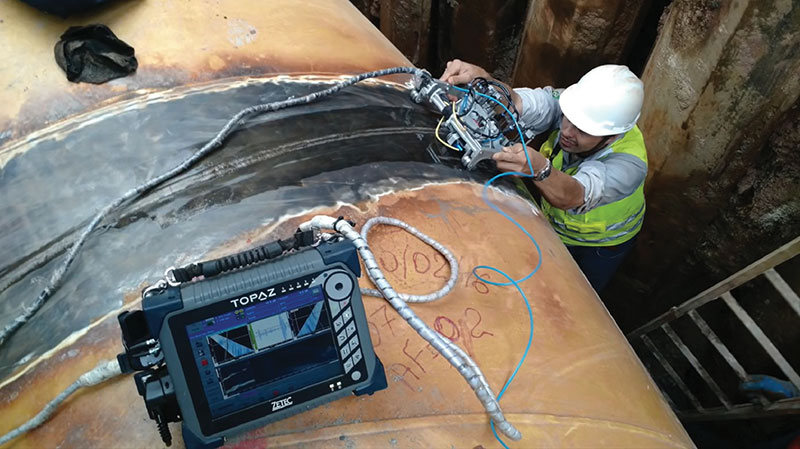Precision Matters: Relied On Pipeline Welding Inspection Providers for Essential Jobs
Wiki Article
Making Best Use Of Efficiency: Pipeline Welding Evaluation Best Practices
By carrying out best techniques for pipeline welding inspection, companies can streamline procedures, decrease errors, and enhance job timelines. The careful interest to information needed in welding examination holds the vital to the long-term longevity and reliability of the pipes, making it a topic of utmost significance in the market.
Relevance of Reliable Welding Evaluations
Efficient welding evaluations play an essential function in guaranteeing the architectural honesty and safety and security of pipes. Appropriate evaluations are important to identify any kind of issues, gaps, or flaws in the bonded joints that can endanger the overall stability of the pipe system. By carrying out detailed inspections, examiners can spot concerns beforehand, protecting against possible leaks, tears, or failures that can have major environmental and safety repercussions.Exact and prompt welding inspections also assist in keeping conformity with market requirements and regulations. Abiding by these criteria is not just a legal requirement but also an essential measure to assure the dependability and long life of the pipes. Reliable evaluations can contribute to cost financial savings by reducing the need for costly repair work or substitutes due to welding issues that could have been avoided or dealt with throughout the examination procedure.
Utilizing Technology for Assessments
To improve the efficacy and accuracy of pipeline welding assessments, the combination of sophisticated technologies has ended up being significantly necessary in making certain accurate and comprehensive analyses of welded joints. One of the key technological developments in pipe welding evaluations is the usage of automated ultrasonic testing (AUT) systems. By accepting these technological options, pipe welding inspections can be conducted extra effectively, leading to greater high quality welds, improved overall security, and reduced project timelines.Developing Clear Inspection Methods
Establishing clear assessment protocols is essential for making certain uniformity and reliability in the pipeline welding evaluation procedure. These protocols act as a set of guidelines that detail the particular steps, criteria, and techniques to be complied with throughout inspections. By clearly specifying the inspection procedures, all inspectors entailed in the procedure can recognize their responsibilities and roles, bring about a more efficient and standardized assessment process.
Normal review and updates to the inspection procedures are likewise essential to adjust to changing industry requirements and demands. By constantly refining and boosting the procedures based upon feedback and lessons discovered, pipe welding evaluations can promote the finest criteria and governing conformity.
Training and Accreditations for Examiners

Training and certifications for assessors are vital in making certain the capability and effectiveness of individuals charged with looking after pipe welding processes - Pipeline Welding Inspection. Properly educated assessors possess the required knowledge and skills to successfully evaluate weld quality, adherence to welding treatments, and conformity with industry standards and guidelines
Certifications, such as those used by the American Welding Society (AWS) or the American Oil Institute (API), verify an examiner's competence and capability to do examinations to the highest possible standards. These qualifications commonly need extensive training, evaluations, and ongoing professional growth to make certain that assessors stay existing with the most up to date developments in welding technology and assessment strategies.
In enhancement to formal certifications, constant training programs play an important role in improving assessors' abilities. These programs cover a vast variety of subjects, consisting of welding procedures, problem discovery, safety and security procedures, and appropriate codes and requirements (Pipeline Welding Inspection). By purchasing thorough training and qualifications for examiners, business can promote the stability of their pipeline welding projects and reduce the dangers related to low quality welds
Continuous Enhancement in Examination Processes
Building upon the foundation of qualified and skilled inspectors, continual enhancement in evaluation processes is important for making sure the ongoing quality and compliance of pipeline welding operations. By carrying out a system of constant renovation, pipeline welding inspection procedures can evolve to meet the changing demands of the market, technological improvements, and regulatory demands. This involves consistently assessing and analyzing assessment devices, techniques, and procedures to determine locations for improvement.One secret element of continuous renovation in inspection processes is comments. Gathering input from assessors, welders, designers, and other stakeholders permits a thorough evaluation of existing practices and the identification of potential locations for renovation. In addition, leveraging data and analytics can supply important understandings right into the effectiveness of assessment processes, allowing informed decision-making for optimization.
In addition, spending in training and advancement programs for assessors can ensure that they are geared up with the most recent knowledge Get More Information and abilities to perform their obligations successfully. Continuous improvement is a dynamic process that needs devotion and dedication from all stakeholders to drive excellence in pipe welding examination practices.
Final Thought
To conclude, maximizing efficiency in pipe welding examinations is critical for making sure the high quality and safety of infrastructure tasks. By making use of technology, developing clear methods, giving correct training and accreditations for examiners, and continuously enhancing inspection procedures, organizations can streamline their operations and decrease dangers. It is critical for markets to prioritize effective welding inspections Look At This to maintain high criteria and fulfill governing needs.
Efficient examinations can contribute to cost savings by minimizing the demand for expensive repair services or substitutes due to welding issues that can have been prevented or dealt with during the inspection procedure.
Establishing clear inspection procedures is vital for making certain uniformity and reliability in the pipe welding examination process. By clearly defining the examination protocols, all examiners included in the process can recognize their duties and roles, leading to an extra effective and standard inspection operations.
Clear evaluation protocols assist in lowering the probability of errors click to investigate or oversights throughout the inspection procedure.Structure upon the foundation of licensed and trained assessors, continuous renovation in assessment processes is crucial for making certain the recurring quality and compliance of pipeline welding operations.
Report this wiki page